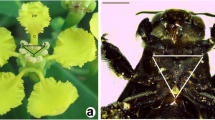Summary
The stigmas of species inAneilema andCommelina are trifid and comprise elongate papillae. Progressive degeneration of papular cells is observed in stigmas from open flowers and at anthesis papillae may be moribund and collapsed. Fluid emanating from the hollow style flows onto the surface through ruptures in the cuticle at the interpapillar junctions into the interstices at maturity. This secretion stains positively for protein. Stigmas are of the “wet” type.
The cuticle overlying the papillar cells is ridged and at the final stages prior to flowering this cuticle becomes detached from the underlying cellulosic wall. The sub-cuticular space so formed is filled with secretion. InAneilema species detachment of cuticle is at the papillar tip and along the lateral walls. InCommelina species the anticlinal walls of adjacent papillae are strongly attached for much of their length and thus detachment of cuticle is restricted to the papillar tip. The cell wall at the tip in both genera may proliferate forming a rudimentary transfer-cell type wall. The secretion is considered to be produced by the papillar cells. It is PAS positive but fails to stain for protein and in both the light and electron microscopes appears heterogenous.
Pollen attachment, hydration, germination and early tube growth are very rapid following self-pollination, the pollen tubes entering the neck of the style within ten minutes of attachment.
A unique character combination involving pollen and stigmas in these genera indicates a monophyletic origin.
Similar content being viewed by others
References
Barka, T., Anderson, P. J., 1962: Histochemical methods for acid phosphatase using hexazonium pararosanilin as coupler. J. Histochem. Cytochem.10, 741–753.
Bronner, R., 1975: Simultaneous demonstration of lipid and starch in plant tissues. Stain Tech.50, 1–4.
Clarke, A. E., Consodine, J. A., Ward, R., Knox, R. B., 1977: Mechanism of pollination inGladiolus: Rôles of the stigma and pollen tube guide. Ann. Bot.41. 15–20.
Dickinson, H. G., Lewis, D., 1973: Cytochemical and ultrastructural differences between intraspecific compatible and incompatible pollinations inRaphanus. Proc. Roy. Soc. (Lond.) B.183, 21–38.
-Moriarty, J. F.,Lawson, J. F., in press: Pollen pistil interaction inLilium longiflorum, the rôle of the pistil in controlling pollen tube growth following cross- and self-pollinations. Proc. Roy. Soc. (Lond.) B.
Faden, R. B., 1975: A biosystematic study of the genusAneilema R. Br. (Commelinaceae). Ph.D. Thesis, Washington University.
Feder, N., O'Brien, T. P., 1968: Plant microtechnique: Some principles and new methods. Amer. J. Bot.55, 123–142.
Fisher, D. B., 1969: Protein staining of ribboned epon sections for light microscopy. Histochemie16, 92–96.
Glauert, A. M., 1975: Fixation, dehydration and embedding of biological specimens. In: Practical methods in electron microscopy3(1). (Glauert, A. M., ed.). North Holland/American Elsevier.
Gurr, E., 1965: The rational use of Dyes in Biology. 422pp. London: Leonard Hill.
Harris, W. M., 1978: Flattening and staining semi-thin epoxy sections of plant material. Stain Tech.53, 298–300.
Herd, Y., Beadle, D. J., 1980: The site of the self-incompatibility mechanism inTradescantia pallida. Ann. Bot.45, 251–256.
Herrero, M., Dickinson, H. G., 1979: Pollen-pistil incompatibility inPetunia hybrida. Changes in the pistil following compatible and incompatible intraspecific crosses. J. Cell. Sci.36, 1–18.
Heslop-Harrison, J., 1976: Amos Memorial Lecture. A new look at pollination. Rep. E. Mailing Res. Stn. for 1975, 141–157.
—, 1979: An interpretation of the hydrodynamics of pollen. Amer. J. Bot.66, 737–743.
—, 1979: Aspects of the structure, cytochemistry and germination of the pollen of rye (Secale cereale). Ann. Bot.44, Suppl.1, 1–47.
Heslop-Harrison, Y., 1975: Fine structure of the stigmatic papilla ofCrocus. Micron6, 45–52.
—, 1980: The pollen-stigma interaction in the Grasses. I. Fine structure and cytochemistry of the stigmas ofHordeum andSecale. Acta Bot.29, 1–16.
—, 1977: The pollen-stigma interaction: Pollen tube penetration inCrocus. Ann. Bot.41, 913–922.
—,Barber, J., 1975: The stigma surface in incompatibility responses. Proc. Roy. Soc. (Lond.) B.188, 287–297.
—,Shivanna, K. R., 1977: The receptive surface of the Angiosperm stigma. Ann. Bot.41, 1233–1258.
Konar, R. N., Linskens, H. F., 1966: Physiology and biochemistry of the stigmatic fluid ofPetunia hybrida. Planta77, 372–387.
Linskens, H. F., Esser, K., 1957: Über eine spezifische Anfärbung der Pollenschläuche in Griffel und die Zahl der Kailosepfropfen nach Selbstung und Fremdung. Naturwissenschaften33, 16.
Mattsson, O., Knox, R. B., Heslop-Harrison, J., HeslopHarrison, Y., 1974: Protein pellicle of stigmatic papillae as a probable recognition site in incompatibility reactions. Nature (Lond.)247, 298–300.
Owens, S. J., 1981: Self-incompatibility in theCommelinaceae. Ann. Bot.47, 567–581.
—,Kimmins, F. M., 1981: Stigma morphology inCommelinaceae. Ann. Bot.47, 771–783.
Poole, M. M., Hunt, D. R., 1980: Pollen morphology and the taxonomy of theCommelinaceae: an exploratory survey. AmericanCommelinaceae: VIII. Kew Bull.34, 639–660.
Pearse, A. G. E., 1972: Histochemistry — theoretical and applied.2, (3rd edn.). Edinburgh and London: Churchill, Livingstone.
Reynolds, E. S., 1963: The use of lead citrate at a high pH as an electron opaque stain in electron microscopy. J. Cell. Biol.17, 208–212.
Author information
Authors and Affiliations
Rights and permissions
About this article
Cite this article
Owens, S.J., Horsfield, N.J. A light and electron microscopic study of stigmas inAneilema andCommelina species (Commelinaceae). Protoplasma 112, 26–36 (1982). https://doi.org/10.1007/BF01280212
Received:
Accepted:
Issue Date:
DOI: https://doi.org/10.1007/BF01280212




